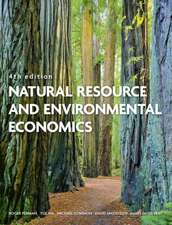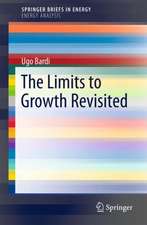Large-Scale Conservation in the Common Interest: Springer Series on Environmental Management
Editat de Susan G. Clark, Aaron M. Hohl, Catherine H. Picard, Elizabeth Thomasen Limba Engleză Hardback – 16 sep 2014
| Toate formatele și edițiile | Preț | Express |
|---|---|---|
| Paperback (1) | 636.12 lei 43-57 zile | |
| Springer International Publishing – 22 sep 2016 | 636.12 lei 43-57 zile | |
| Hardback (1) | 642.18 lei 43-57 zile | |
| Springer International Publishing – 16 sep 2014 | 642.18 lei 43-57 zile |
Din seria Springer Series on Environmental Management
- 18%
 Preț: 1230.84 lei
Preț: 1230.84 lei - 18%
 Preț: 1236.51 lei
Preț: 1236.51 lei - 18%
 Preț: 953.82 lei
Preț: 953.82 lei - 18%
 Preț: 779.08 lei
Preț: 779.08 lei - 15%
 Preț: 642.83 lei
Preț: 642.83 lei - 15%
 Preț: 677.85 lei
Preț: 677.85 lei - 15%
 Preț: 640.06 lei
Preț: 640.06 lei - 15%
 Preț: 640.06 lei
Preț: 640.06 lei - 15%
 Preț: 635.47 lei
Preț: 635.47 lei - 15%
 Preț: 505.49 lei
Preț: 505.49 lei - 18%
 Preț: 1236.69 lei
Preț: 1236.69 lei - 18%
 Preț: 962.98 lei
Preț: 962.98 lei - 15%
 Preț: 640.06 lei
Preț: 640.06 lei - 15%
 Preț: 638.24 lei
Preț: 638.24 lei - 15%
 Preț: 634.68 lei
Preț: 634.68 lei - 18%
 Preț: 959.82 lei
Preț: 959.82 lei - 15%
 Preț: 641.03 lei
Preț: 641.03 lei - 15%
 Preț: 653.46 lei
Preț: 653.46 lei -
 Preț: 399.50 lei
Preț: 399.50 lei -
 Preț: 387.38 lei
Preț: 387.38 lei - 18%
 Preț: 950.66 lei
Preț: 950.66 lei - 15%
 Preț: 651.99 lei
Preț: 651.99 lei - 18%
 Preț: 957.62 lei
Preț: 957.62 lei - 15%
 Preț: 647.40 lei
Preț: 647.40 lei - 18%
 Preț: 945.79 lei
Preț: 945.79 lei - 18%
 Preț: 1218.69 lei
Preț: 1218.69 lei - 15%
 Preț: 634.68 lei
Preț: 634.68 lei - 18%
 Preț: 1225.79 lei
Preț: 1225.79 lei - 15%
 Preț: 657.25 lei
Preț: 657.25 lei -
 Preț: 397.38 lei
Preț: 397.38 lei -
 Preț: 404.89 lei
Preț: 404.89 lei - 15%
 Preț: 641.03 lei
Preț: 641.03 lei - 15%
 Preț: 650.86 lei
Preț: 650.86 lei - 15%
 Preț: 711.21 lei
Preț: 711.21 lei - 15%
 Preț: 643.16 lei
Preț: 643.16 lei - 18%
 Preț: 724.80 lei
Preț: 724.80 lei - 15%
 Preț: 635.47 lei
Preț: 635.47 lei
Preț: 642.18 lei
Preț vechi: 755.51 lei
-15% Nou
Puncte Express: 963
Preț estimativ în valută:
122.92€ • 133.56$ • 103.32£
122.92€ • 133.56$ • 103.32£
Carte tipărită la comandă
Livrare economică 21 aprilie-05 mai
Preluare comenzi: 021 569.72.76
Specificații
ISBN-13: 9783319074184
ISBN-10: 3319074180
Pagini: 191
Ilustrații: XIV, 191 p. 8 illus.
Dimensiuni: 155 x 235 x 20 mm
Greutate: 0.47 kg
Ediția:2015
Editura: Springer International Publishing
Colecția Springer
Seria Springer Series on Environmental Management
Locul publicării:Cham, Switzerland
ISBN-10: 3319074180
Pagini: 191
Ilustrații: XIV, 191 p. 8 illus.
Dimensiuni: 155 x 235 x 20 mm
Greutate: 0.47 kg
Ediția:2015
Editura: Springer International Publishing
Colecția Springer
Seria Springer Series on Environmental Management
Locul publicării:Cham, Switzerland
Public țintă
GraduateCuprins
Chapter 1: A Problem-Oriented View of Large-Scale Conservation.- Chapter 2: The Importance of People, Institutions, and Resources in Large-Scale Conservation.- Chapter 3: Approaches to Large-Scale Conservation: A Survey.- Chapter 4: The Connecticut River Watershed: Using Adaptive Governance Arenas for Collaboration and Integration.- Chapter 5: The Greater Yellowstone Ecosystem: A Rapid Appraisal and Recommendations.- Chapter 6: The Last Green Valley: Modernization and Sustainability in a Tri-State Area.- Chapter 7: Conserving Trail Corridors: The Pacific Crest National Scenic Trail.- Chapter 8: Conserving Tanzania's Wildlife: What is the Policy Problem.- Chapter 9: The Humboldt Bay Initiative: Integrating People and Natural Resources in Northern California.- Chapter 10: Large-Scale Conservation in the Common Interest: Conclusions and Recommendations.
Recenzii
“This work is among the first generation of publications on conservation at large scales, with both conceptual and applied components. … A useful resource for advanced students, policy makers, and practitioners in conservation and natural resource management. Summing Up: Recommended. Upper-division undergraduates and above.” (J. Chen, Choice, Vol. 52 (8), April, 2015)
Notă biografică
Susan Clark’s primary goal in her research and teaching is to improve conservation of species and ecosystems at professional, scientific, organizational and policy levels. In addition to ecological and behavioral field research on thirty-five mammals and other species, she has conducted research and applied projects in North America, Australia, Asia and Central America, building case studies, evaluating policies and programs, helping organizations to incorporate reliable science into management, helping students to develop proficiency in the policy sciences method of problem solving and working with a wide range of groups to improve conservation problem solving through workshops and other analytic exercises. Recent books include Large Carnivore Conservation: Integrating Science and Policy in the North American West (2014), The Policy Process: A Practical Guide for Natural Resource Professionals (2002) and Foundations of Natural Resources Policy and Management (2000). She is a professor (adjunct) at the Yale School of Forestry and Environmental Studies.
Aaron Hohl holds a Ph.D. in forestry and environmental studies from Yale University, a M.E.M. in landscape ecology from Duke University and a B.S. in biology and philosophy from John Carroll University. He has worked as an agroforestry extension agent and technical trainer for the U.S. Peace Corps in Paraguay, a forest ecologist for the Forest Service’s Southern Global Change Program, and a natural resource consultant to both governmental and non-governmental organizations. His research has taken him from the mixed hardwood forests of North Carolina’s Appalachian Mountains to the radioactive pine forests of the Chernobyl Exclusion Zone. He is an ARB-accredited lead verifier for forest carbon offset projects. He is currently a lecturer in the Department of Forestry and Wildland Resources at Humboldt State University, where he has taught courses in forest management, forest mensuration andenvironmental economics.
Catherine Picard is based in Burlington, Vermont, where she is an environment and natural resources associate with Tetra Tech/Associates in Rural Development. The daughter of a foreign service officer, she has lived and worked throughout sub Saharan Africa and developed a passion early on for international natural resource conservation and development. Prior to joining Tetra Tech, Catherine served for three years with the U.S. State Department’s Bureau of African Affairs, where she focused on the intersection of conflict and natural resources, including conflict diamonds and minerals and the transboundary management of the Nile Basin. Before that, she spent five years in Chicago with the MacArthur Foundation as the director of administration and a program officer for cross cutting grants in international conservation and development. Dr. Picard holds a Ph.D. from Yale University as well as master’s and undergraduate degrees from University of Michigan and the University of California at Berkeley, respectively.
Elizabeth Thomas is based in Denver, Colorado, where she works with governments, communities and non-profits on the interplay between conservation, land use decisions and people. She has worked as a corporate sustainability analyst consulting with Fortune 500 companies and as an ecological field researcher in the Eastern Sierra of California. She holds a master’s degree in environmental science from the Yale School of Forestry and Environmental Studies and an undergraduate degree in environment, economics and politics from Claremont McKenna College.
Aaron Hohl holds a Ph.D. in forestry and environmental studies from Yale University, a M.E.M. in landscape ecology from Duke University and a B.S. in biology and philosophy from John Carroll University. He has worked as an agroforestry extension agent and technical trainer for the U.S. Peace Corps in Paraguay, a forest ecologist for the Forest Service’s Southern Global Change Program, and a natural resource consultant to both governmental and non-governmental organizations. His research has taken him from the mixed hardwood forests of North Carolina’s Appalachian Mountains to the radioactive pine forests of the Chernobyl Exclusion Zone. He is an ARB-accredited lead verifier for forest carbon offset projects. He is currently a lecturer in the Department of Forestry and Wildland Resources at Humboldt State University, where he has taught courses in forest management, forest mensuration andenvironmental economics.
Catherine Picard is based in Burlington, Vermont, where she is an environment and natural resources associate with Tetra Tech/Associates in Rural Development. The daughter of a foreign service officer, she has lived and worked throughout sub Saharan Africa and developed a passion early on for international natural resource conservation and development. Prior to joining Tetra Tech, Catherine served for three years with the U.S. State Department’s Bureau of African Affairs, where she focused on the intersection of conflict and natural resources, including conflict diamonds and minerals and the transboundary management of the Nile Basin. Before that, she spent five years in Chicago with the MacArthur Foundation as the director of administration and a program officer for cross cutting grants in international conservation and development. Dr. Picard holds a Ph.D. from Yale University as well as master’s and undergraduate degrees from University of Michigan and the University of California at Berkeley, respectively.
Elizabeth Thomas is based in Denver, Colorado, where she works with governments, communities and non-profits on the interplay between conservation, land use decisions and people. She has worked as a corporate sustainability analyst consulting with Fortune 500 companies and as an ecological field researcher in the Eastern Sierra of California. She holds a master’s degree in environmental science from the Yale School of Forestry and Environmental Studies and an undergraduate degree in environment, economics and politics from Claremont McKenna College.
Textul de pe ultima copertă
Many people working toward sustainability recognize the important role of conservation but are inadequately prepared to deal with the large spatial, temporal, and complexity scales that are involved in large-scale conservation efforts. Problems in large-scale conservation require navigating an intermixture of geophysical, biological, and political dimensions. Coming to grips with these many natural and human forces and factors at large scales, much less the myriad details in any single case, is challenging in the extreme and becomes more critical with each day that passes.
Large-scale conservation poses many complex challenges that single disciplines, approaches, or methods cannot fully address alone. Interdisciplinarity can significantly strengthen large-scale conservation efforts. Throughout Large-Scale Conservation in the Common Interest the editors and authors argue that a more holistic and genuinely interdisciplinary approach is required to solve the complex and growing challenges associated with large-scale conservation. The chapters within offer such an approach and define key terms, bring challenges to light, and employ case studies to offer concrete practical and strategic recommendations to help those who are engaged in the interactive tasks of promoting sustainability and human dignity.
This book is intended for a broad audience, including students and professors new to the field of large-scale conservation, experienced field-based practitioners in science and management, and decision and policy makers who set specific and strategic direction for large landscapes. Professors can use this book to introduce students to the challenges of successful large-scale conservation design and implementation and to teach interdisciplinarity as a framework, concept, and tool. Professionals will findthis book offers a new way of using science, management, and policy to make decisions. Finally, this volume can be used as a guide to set up workshops, seminars, or projects involving diverse people and perspectives.
Large-scale conservation poses many complex challenges that single disciplines, approaches, or methods cannot fully address alone. Interdisciplinarity can significantly strengthen large-scale conservation efforts. Throughout Large-Scale Conservation in the Common Interest the editors and authors argue that a more holistic and genuinely interdisciplinary approach is required to solve the complex and growing challenges associated with large-scale conservation. The chapters within offer such an approach and define key terms, bring challenges to light, and employ case studies to offer concrete practical and strategic recommendations to help those who are engaged in the interactive tasks of promoting sustainability and human dignity.
This book is intended for a broad audience, including students and professors new to the field of large-scale conservation, experienced field-based practitioners in science and management, and decision and policy makers who set specific and strategic direction for large landscapes. Professors can use this book to introduce students to the challenges of successful large-scale conservation design and implementation and to teach interdisciplinarity as a framework, concept, and tool. Professionals will findthis book offers a new way of using science, management, and policy to make decisions. Finally, this volume can be used as a guide to set up workshops, seminars, or projects involving diverse people and perspectives.
Caracteristici
An dynamic, holistic and interdisciplinary approach to large scale conservation efforts Case studies in large scale conservation from Connecticut to Tasmania serve as frameworks and tools of interdisciplinarity Content is engineered toward a broad audience of students, academics and professionals Includes supplementary material: sn.pub/extras














